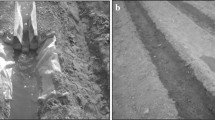Summary
In models used for relating the yield to irrigation uniformity it has been assumed that the spatial distribution of irrigation water, as measured at the soil surface, is indeed the water distribution at any depth throughout the root zone. In the present paper the distribution of infiltrated water within the soil bulk, as determined by an analytic solution of the two-dimensional unsaturated flow equation, did not conform to this assumption. A new alternative definition of irrigation uniformity is proposed under the assumption that water uptake by roots does not affect the flux distribution within the soil profile. In this analysis the spatial distribution of irrigation water flux at the soil surface, which is the upper boundary condition of the flow equation, is assumed to be a sine function. The solution to this problem indicates that there is a “damping” effect, which increases with soil depth, on the surface flux fluctuations. Furthermore, the actual irrigation uniformity at a given depth below the soil surface depends upon the initial uniformity at the surface and the distance between adjacent water sources. The closer the water sources are to each other, the shallower is the depth needed to damp the oscillations down to a certain level. This may explain why the actual uniformity of drip irrigation is high while the detailed distribution is very nonuniform and on the other hand, why the actual uniformity of sprinkler guns is low while the detailed actual distribution is close to uniform. Two uniformity coefficients are derived in this study: 1. A depth dependent coefficient which is made up of the damping factor that multiplies the flux fluctuations at the soil surface; 2. An effective uniformity coefficient, which is an average of the depth dependent coefficient over a part or the entire root zone. Different degrees of uniformity are expected when water is applied by different irrigation systems having similar uniformity coefficients at the soil surface, but dissimilar distances between the emitters. Assuming that crop yield depends to some extent on the uniformity of water depth actually available to the roots, the yields associated with such irrigation systems will probably also vary.
Similar content being viewed by others
References
Batu V, Gardner WR (1978) Steady state solute convection in two-dimensions with nonuniform infiltration. Soil Sci Soc Am J 40:18
Bresler E (1978) Analysis of trickle irrigation with application to design problems. Irrig Sci 1:3
Christiansen JE (1942) Irrigation by sprinkling. California Agricultural Experiment Station — Bulletin 670
Cohen OP, Bresler E (1967) The effect of non-uniform water application on soil moisture content, moisture depletion, and irrigation efficiency. Soil Sci Soc Am Proc 31:117
Cogels OG (1983) An irrigation system uniformity function relating the effective uniformity on water application to the scale of influence of the plant root zone. Irrig Sci 4:289
Gardner WR (1958) Some steady-state solutions for the unsaturated moisture flow equation with application to evaporation from a water table. Soil Sci 85:228
Hart WE (1972) Subsurface distribution of nonuniformly applied surface waters. Trans ASAE 15:656
Philip JR (1983) Infiltration in one, two, and three dimensions. Advances in infiltration. Proc. Nat. Conf on Advances in Infiltration ASAE, St Joseph MI 1–13
Philip JR (1984) Nonuniform leaching from nonuniform steady infiltration. Soil Sci Soc Am J 40:740
Seginer I (1979) Irrigation uniformity related to horizontal extent of root zone. Irrig Sci 1:89
Seginer I (1987) Spatial water distribution in sprinkler irrigation. Adv Irrig 4:119
Wallach R (1985) Solution for sub-surface runoff in a watershed. Ph.D. dissertation, Technion — Israel Institute of Technology (in hebrew)
Wallach R, Zaslavsky D, Israeli M (1989) Small perturbations solution for steady but nonuniform infiltration. Water Resources Research (in press)
Warrick AW (1983) Interrelationships of irrigation uniformity terms. J Irrig Drain Div ASCE 109:317
Warrick AW, Lomen DO (1981) Two-dimensional linearized moisture flow with water extraction. J Hydrol 49:235
Wilcox JC, Swailes GE (1947) Uniformity of water distribution by some undertree orchard sprinklers. Sci Agric 27:565
Zaslavsky D, Buras N (1967) Crop yield response to nonuniform application of irrigation water. Trans ASAE 10:196
Zaslavsky D, Sinai G (1981) Surface hydrology: 1 — Explanation of phenomena. J Hydraul Div ASCE 107:1
Author information
Authors and Affiliations
Rights and permissions
About this article
Cite this article
Wallach, R. Effective irrigation uniformity as related to root zone depth. Irrig Sci 11, 15–21 (1990). https://doi.org/10.1007/BF00189990
Received:
Issue Date:
DOI: https://doi.org/10.1007/BF00189990




